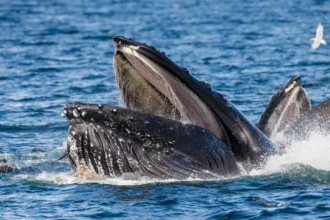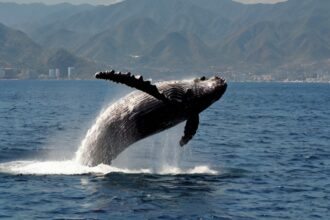Humpback Whale Anatomy
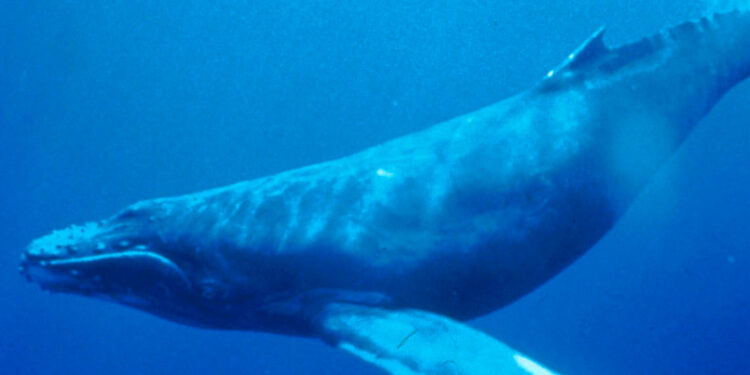
Scientists remain amazed by humpback whale’s remarkable anatomical features. These magnificent creatures can reach lengths of up to 52 feet and weigh as much as 40 tons, which makes them one of the ocean’s most impressive inhabitants. The largest recorded female humpback whale measured an extraordinary 89 feet and weighed 99 tons.
The marine giants stand out from other whale species with their unique physical characteristics. Their distinctive pectoral fins stretch to 15 feet in length and make up one-third of their body length. The whale’s specialized body structure has 270 to 400 pairs of baleen plates that filter food, along with a thick blubber layer measuring 8 to 12 inches that provides vital insulation in cold waters.
This complete guide explores the sort of thing I love about humpback whales’ anatomical features. Recent scientific findings have revolutionized our understanding of these remarkable marine mammals.
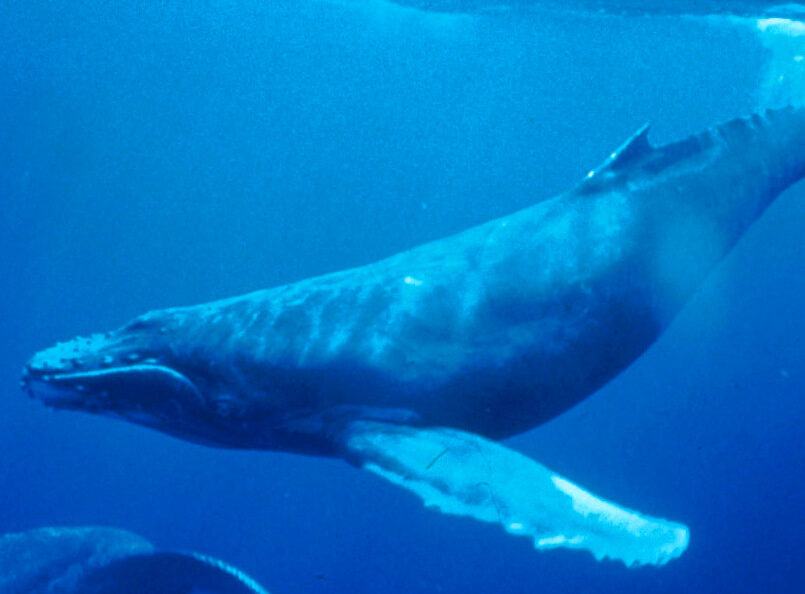
Table of Contents
- 1 Remarkable Size and Structure of Humpback Whales
- 2 The Complex Anatomy of a Humpback Whale’s Head
- 3 Advanced Feeding Mechanisms
- 4 Newly Discovered Sensory Systems
- 5 Revolutionary Findings About Whale Skin
- 6 FAQs about the humpback whale anatomy:
- 6.1 What do humpback whales eat in Mexico?
- 6.2 What are 3 interesting facts about humpback whales?
- 6.3 Do humpback whales give birth in Mexico?
- 6.4 What is the anatomy of a humpback whale?
- 6.5 Can you swim with humpback whales in Mexico?
- 6.6 Why are there so many whales in Cabo?
- 6.7 How long do humpback whale calves stay with their mother?
- 6.8 Have humpback whales been filmed mating?
- 6.9 Where do humpback whales go to have their babies?
Remarkable Size and Structure of Humpback Whales
The humpback whale’s size shows nature at its finest. These magnificent creatures reach lengths of 46 to 56 feet, and females grow 3 to 5 feet longer than males. Their weight ranges from 25 to 40 tons, with some growing even larger.
Understanding how big humpback whales really are
These marine mammals become even more impressive up close. Their massive tail flukes stretch up to 18 feet across, and their distinctive pectoral fins extend to 15 feet. These giants need about 3,000 pounds of food each day to maintain their enormous size.
The streamlined body design for ocean life
Humpback whales have evolved a perfect shape to live in the ocean. Their torpedo-like body glides through water effortlessly, and their sleek structure has no unnecessary features. They have just a few bristles of hair on their head and no external ear flaps. The peduncle muscle between their dorsal fin and flukes stands out as the animal kingdom’s strongest muscle.
Key anatomical proportions and measurements
The humpback whale’s body shows remarkable balance in its design. A dorsal fin sits about two-thirds down their back and rises about 12 inches high. These giants have 14 to 35 throat grooves and 540 to 800 black baleen plates. Their body coloring follows a distinct pattern:
- Black covers most of the upper body
- The underside shows mixed black and white patterns
- Whales in the southern hemisphere tend to have more white areas
Their thick blubber layer measures 8 to 12 inches and keeps them warm while helping them float. The unique bumps on their head measure 5-10 centimeters at the base and stick out up to 6.5 centimeters. These tubercles contain sensitive nerve endings that might help them sense their environment.
The Complex Anatomy of a Humpback Whale’s Head
The massive heads of humpback whales hide a complex network of specialized organs and sensory systems beneath their surface. Their head anatomy shows sophisticated adaptations that help them thrive in marine environments.
Specialized features of the whale mouth anatomy
The rostrum, or upper jaw, has a distinctive flat shape that narrows to a point and creates a smooth profile. The surface features many bumps called tubercles that contain sensitive vibrissae (hair-like structures) which act as tactile sensors. These sensory hairs stick out 1-3 centimeters from the skin. Scientists have found that there was a grapefruit-sized sensory organ between the jaw tips that manages the complex mechanism of lunge-feeding.
The dual blowhole breathing system
Humpbacks, being baleen whales, have two blowholes on top of their heads. These modified nostrils let them breathe while keeping most of their body underwater. At the time they surface, they first exhale at an impressive speed of 300 miles per hour and create mist fountains up to 15 feet high. The blowholes’ strong muscles seal them tightly underwater, which stops water from entering during dives.
Sensory organs and brain structure
A humpback whale’s brain shows remarkable complexity, as shown by:
- A brain mass of 4.6 kilograms with dimensions of 22.4 cm length and 18 cm width
- Specialized acoustic imaging areas ten times larger than visual processing regions
- Unique “spindle cells” that scientists thought existed only in humans and great apes
Their eyes sit seven feet from the rostrum tip and contain thick, flexible white portions that can handle high diving pressures. The eye muscles can bend to focus both above and below water, which helps them adapt to low-light conditions. Notwithstanding that, their hearing abilities are even more remarkable, ranging between 15 Hz and 3 kHz when stimulated at the tympanic membrane.
Recent research shows that humpback whale’s skin has an exceptionally dense network of nerves, which suggests advanced tactile sensitivity. This complex sensory system helps them detect subtle changes in water movement and pressure, which explains their impressive navigation abilities.
Advanced Feeding Mechanisms
The humpback whale’s feeding system shows nature’s amazing engineering at work. Their mouth has 270 to 400 pairs of baleen plates that work as nature’s quickest way to filter food.
Inside the humpback whale mouth structure
Looking inside the whale’s mouth shows how well it’s built for filter feeding. A special sensory organ sits between the lower jaw bones and controls their complex lunge-feeding process. The jaw connects to the skull through giant pads of dense, elastic matrix that lets the whale open its mouth almost 90 degrees. This flexibility helps the whale catch more food.
How baleen plates function as filters
The whale starts filtering by opening its huge mouth underwater to catch prey. The plates are made of keratin, just like human fingernails, and hang down from the upper jaw. Each plate is about two feet long with a smooth outer edge and frayed inner surface. These frayed edges weave together to make a dense mat that traps food but lets water flow out.
Throat grooves and feeding adaptations
The ventral groove system has 14-35 expandable pleats that run from the lower jaw to the navel. These amazing structures let the whale:
- Make its throat 162% wider and 38% longer
- Take in 15,000 gallons of water in one gulp
- Handle more water than its own body size
The whale coordinates this complex feeding process perfectly. Its soft tongue folds into a special space called the cavum ventrale, which creates a huge sac for water. Scientists found that there was an “oral plug” that keeps the whale from choking by sealing its breathing passage while eating.
Strong muscles in the whale’s belly and tongue push water through the baleen plates to strain out food. This advanced filtering system lets humpbacks eat thousands of pounds of krill and small fish each day. The whale’s knowing how to use bubble-net feeding and its body adaptations make it one of the ocean’s best filter feeders.
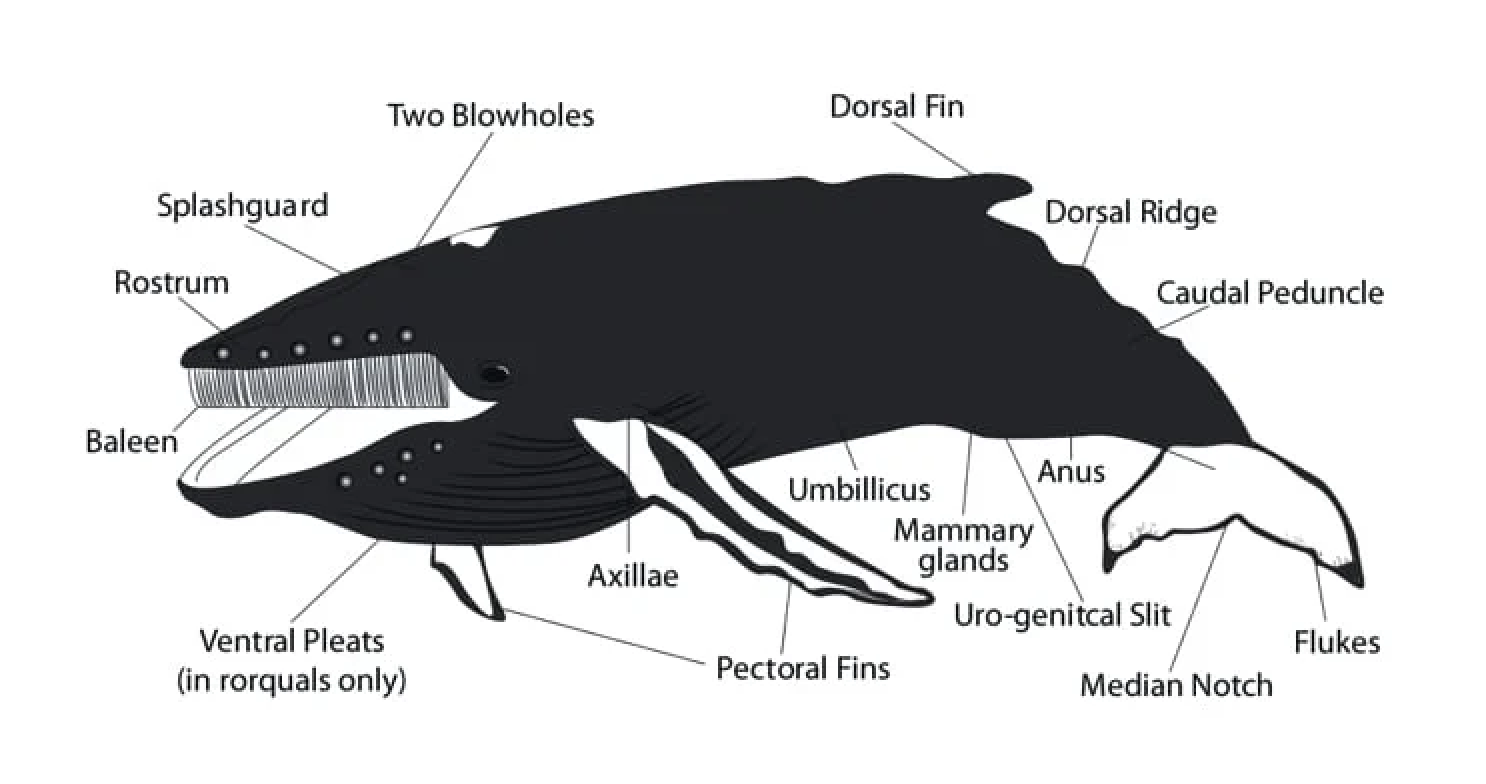
Newly Discovered Sensory Systems
Scientific findings have revealed extraordinary sensory systems in humpback whales that expand our knowledge of these marine giants. Scientists have found sophisticated anatomical features that make precise navigation and complex communication possible.
Previously unknown sensory organs
Scientists have found a remarkable grapefruit-sized sensory organ between the tips of the jaws. This organ stays suspended in a gel-like material and contains connective tissue with nerve-rich papillae. The specialized structure helps coordinate the complex mechanism of lunge-feeding by responding to jaw movements and throat expansion.
The scientists have also identified an exceptionally dense network of nerves in humpback whale’s skin. This intricate system lets whales detect subtle changes in water movement and pressure. The skin’s sensory afferents show unique adaptations and form thread-like bundles that follow winding paths through the dermis.
Humpback whales show remarkable directional precision during their oceanic travels. These mammals can keep steady courses over big distances, ranging from 240 to 2,230 kilometers. Their navigation skills become even more impressive as they adjust for changing sea-surface currents while staying on course.
The whales’ navigation capabilities include:
- Knowing how to travel 5,000 miles between breeding and feeding grounds
- Keeping course direction with less than one degree of deviation
- Directing themselves through turbulent waters while maintaining straight paths
Communication system anatomy
Scientists have identified a specialized voice box unique to baleen whales. These whales have a U-shaped tissue instead of vocal cords that lets them breathe in massive amounts of air, along with a large cushion of fat and muscle. This distinctive anatomy lets them create sounds by pushing tissue against the fat and muscle cushion.
The communication system is vital for survival since sound remains the primary way to find mates in big oceans. Their vocal apparatus makes complex acoustic signals possible that can travel hundreds or thousands of miles underwater. Sound production and reception are the most significant senses for these marine mammals, which let them coordinate movements and keep social connections across vast oceanic distances.
Revolutionary Findings About Whale Skin
Scientists who study humpback whale skin have found amazing details about its complex structure and functions. New research shows these whales have a much more sophisticated skin system than we first thought.
Unique properties of whale skin
Humpback whale skin’s outer layer has remarkable features. It feels like smooth, wet rubber when touched and pulls in water to improve movement through the ocean. The epidermis is incredibly thick – up to 50 times thicker than what we see in land mammals.
The skin has three distinct layers, unlike other mammals that have five. The epidermis has a water-resistant outer layer where live cells slowly transition to dead ones. This makes it different from land mammals that have a fully cornified layer.
Specialized dermal adaptations
The dermis shows amazing organizational complexity. Small arteries weave through a deep neural plexus that connects to a subepidermal neural plexus near the surface. This creates an incredibly dense low-threshold mechanosensory system.
Scientists found something unusual – an acellular gap between the perineural sheaths and central axon cores in all skin nerves. This clever adaptation helps prevent high water pressure from disrupting nerve signals during deep dives.
The skin hosts several essential bacterial communities that keep whales healthy. Research shows that:
- Almost all whales have six core bacterial communities on their skin
- Four new bacterial groups show up in late summer after feeding periods
- These microbes might produce antibiotics to fight off harmful bacteria
Recent discoveries about skin function
Scientists have noticed fascinating behaviors related to skin care. Whales often do “sand rolling” where they rub against sandy ocean floors. This behavior:
- Makes dead skin cells fall off faster
- Gets rid of young barnacles in hard-to-reach spots
- Helps clean possible wounds
Whales shed their skin more as they swim between warm and cold waters. This constant renewal is vital to reduce infection risks from bacteria and viruses. The skin’s bacterial community also changes with seasonal water temperature shifts, which suggests it adapts to environmental changes.
These findings show how the skin works as a sophisticated environmental interface. Skin samples give us valuable information about whale health, nutrition, and environmental responses. This knowledge is becoming more important as we monitor how these marine mammals adapt to pollution, ecosystem changes, and climate change.
Humpback whale anatomy shows nature’s engineering brilliance. Scientists keep finding amazing features that reveal these marine giants’ sophisticated biological systems. Their huge bodies give them specialized feeding mechanisms and complex sensory organs that help them thrive in ocean life.
The whale’s skin structure and newly found sensory organs have reshaped our scientific understanding of these magnificent creatures. What scientists once called a large marine mammal now stands as one of the ocean’s most sophisticated organisms. These whales can travel big oceanic distances thanks to their skin’s intricate nerve network and specialized organs for feeding and navigation.
We have a long way to go, but we can build on this progress in understanding humpback whale anatomy. Each discovery leads to new questions about these remarkable creatures, and more fascinating findings lie ahead. These gentle giants keep surprising researchers with their biological complexity. They truly deserve their place as one of nature’s most extraordinary masterpieces.
FAQs about the humpback whale anatomy:
What do humpback whales eat in Mexico?
Humpback whales in Mexico primarily feed on small fish, krill, and plankton. Using their unique humpback whale mouth anatomy, they employ a technique called bubble-net feeding to trap and consume large quantities of prey. This feeding behavior is fascinating to observe and is a key part of their diet during their time in warmer waters.
What are 3 interesting facts about humpback whales?
First, humpback whales are known for their complex songs, which can last up to 20 minutes and be heard for miles underwater. Second, their humpback whale anatomy includes long pectoral fins, which can reach up to one-third of their body length. Third, they are highly migratory, traveling thousands of miles between feeding and breeding grounds, such as the warm waters of Mexico.
Do humpback whales give birth in Mexico?
Yes, humpback whales give birth in the warm, protected waters of Mexico, particularly in areas like Banderas Bay and the Sea of Cortez. The anatomy of a humpback whale is well-suited for calving in these regions, as the warm temperatures provide a safe environment for newborns to develop and nurse before migrating to colder feeding grounds.
What is the anatomy of a humpback whale?
The anatomy of a humpback whale includes a large, streamlined body, long pectoral fins, and a distinctive dorsal fin. Their humpback whale mouth anatomy features baleen plates instead of teeth, which they use to filter feed on small fish and krill. A humpback whale anatomy diagram often highlights their unique throat grooves, which expand to take in large volumes of water and prey.
Can you swim with humpback whales in Mexico?
Swimming with humpback whales in Mexico is possible but highly regulated to protect both the whales and humans. Observing the anatomy of a humpback whale up close is an awe-inspiring experience, but it requires following strict guidelines to ensure the safety and well-being of these majestic creatures.
Why are there so many whales in Cabo?
Cabo is a hotspot for whales, including humpbacks, due to its warm waters and abundant food supply. The anatomy of a humpback whale makes it well-suited for breeding and calving in this region, attracting large numbers during the winter months. This makes Cabo a prime location for whale watching and studying humpback whale anatomy.
How long do humpback whale calves stay with their mother?
Humpback whale calves typically stay with their mothers for about 10 to 12 months. During this time, the calves rely on their mother’s milk, which is rich in fat, to grow and develop their humpback whale anatomy. This period is crucial for the calves to gain strength before migrating to colder feeding grounds.
Have humpback whales been filmed mating?
Yes, humpback whales have been filmed mating, though such footage is rare due to the challenges of capturing these events underwater. The anatomy of a humpback whale plays a key role in their mating behaviors, which often involve complex courtship displays and vocalizations. These recordings provide valuable insights into their reproductive habits.
Where do humpback whales go to have their babies?
Humpback whales migrate to warm, tropical waters, such as those off the coast of Mexico, to give birth. The anatomy of a humpback whale is adapted for calving in these regions, where the warm temperatures help newborns thrive. Areas like Banderas Bay and the Sea of Cortez are popular birthing grounds for these majestic creatures.
